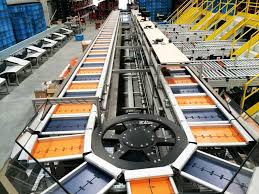How Automation with Conveyor Systems is Revolutionizing Material Handling

In today’s competitive manufacturing and logistics environment, companies are constantly looking for ways to speed up operations, reduce costs, and minimize errors. One of the most impactful advancements in this space is automation with conveyor systems. By combining traditional conveyor technology with advanced automation tools, businesses can transform their workflows and stay ahead in a demanding marketplace.
What is Automation with Conveyor Systems?
Automation with conveyor systems refers to the integration of automated controls, robotics, and sensors with conveyor equipment to streamline the movement of goods. Instead of relying solely on human labor for loading, sorting, and transporting materials, automated systems handle these tasks with minimal human intervention.
These systems can:
- Sort packages by size, weight, or destination.
- Integrate with warehouse management software for real-time tracking.
- Operate 24/7 without fatigue, increasing throughput.
Key Components of Automated Conveyor Systems
An effective automated conveyor setup includes several essential components:
- Conveyor Belts or Rollers: The transport medium for goods.
- Automated Drives and Motors: Control movement speed and direction.
- Sensors and Scanners: Detect and identify products instantly.
- Robotic Integrations: Pick, place, and sort items with precision.
- Control Software: Manages the entire process for maximum efficiency.
These elements work together to create a seamless, high-speed material handling process.
Benefits of Automation with Conveyor Systems
Businesses adopting automated conveyor technology experience several advantages:
- Faster Processing Times – Continuous operation reduces bottlenecks.
- Lower Labor Costs – Fewer manual handling requirements mean reduced staffing needs.
- Improved Accuracy – Automated scanning and sorting eliminate most human errors.
- Enhanced Safety – Reduces worker exposure to heavy lifting or hazardous areas.
- Scalability – Systems can expand to meet increased demand.
Industries Benefiting from Automation with Conveyor Systems
This technology is used across multiple industries, including:
- E-commerce and Retail Fulfillment: Fast order processing and shipping.
- Manufacturing: Efficient movement of raw materials and finished products.
- Food & Beverage: Hygienic, controlled transportation of goods.
- Pharmaceuticals: Accurate, safe handling of sensitive products.
- Postal and Logistics Services: High-speed sorting of letters and parcels.
Choosing the Right Automated Conveyor Solution
When selecting a system, businesses should consider:
- Product type and size variations.
- Speed and throughput requirements.
- Integration with existing warehouse or manufacturing equipment.
- Space constraints and layout.
Consulting with an experienced conveyor solutions provider ensures the system is tailored to your exact needs and future growth plans.
Final Thoughts
In an era where speed, precision, and efficiency are crucial, automation with conveyor systems is more than just an upgrade—it’s a competitive necessity. By adopting this technology, businesses can cut costs, improve safety, and meet rising customer expectations with ease.



